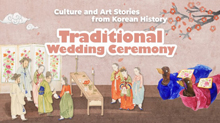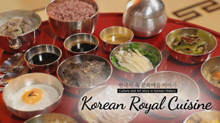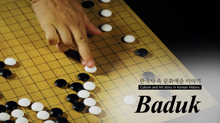The Story of Culture and Arts
- Image resource of Korean history
- Documents from History TextBooks
- Culture & Art Stories from Korean History
- Culture & Art Stories from Korean History - Korean
- National Institute of Korean History
- History net
- About the site
- Introduce
-
Numerous topics related to Korean culture and art are mentioned in middle and high school national history textbooks, but most of them are briefly described by era, making it difficult to understand their concepts, transition processes, and characteristics.
<Culture & Art Stories from Korean History> produces and provides video materials based on expert commentary on the flow, change process, characteristics and characteristics of each major topic in the field of culture and art in Korean history.

Scenario
People have gathered here for a special activity.
And that is to make the representative of all Korean cuisine-kimchi. Kimchi is not at all easy to make.
The star of Korean culinary culture, kimchi.
The act of kimjang-gathering together to make kimchi and bond-is a longstanding Korean tradition that continues even today.
Then, why and when did people start eating kimchi?
Why People Began Making Kimchi
Kimchi, which you'll find on every Korean's table today, was also a common sidedish on Korean dinner tables of the past. Regardless of its various names, kimchi has held the top spot at Korean meals for a very long time.
In the summer it is good to eat when pickled in a sauce. If pickled with salt, it will last well beyond the long winter. - Yi Gyubo(1168–1241), Dongguk Yi Sanggukjip [Collected Works of Yi Gyubo of Korea]
In a poem by the Goryeo poet Yi Gyubo, you'll find the first recorded reference to kimchi. In this poem, one learns that in the late Goryeo period turnips were covered in a sauce and pickled in summer, while in winter they were pickled in brine.
Time passed, and in the early Joseon period, more vegetables and more seasonings were used to make kimchi.
In the hills near my home are some empty plots of land.
Every year I plant many vegetables.
Turnips, radishes, and lettuce,
Watercress, taro, and perilla mint.
Combining ginger, garlic, scallions, and water pepper to create a seasoning of five flavors,
I boil a sauce in which vegetables are steeped to make kimchi.
- Seo Geojeong, Sokdongmunseon [Supplementary Anthology of Korean Literature]
In this early Joseon poem by Seo Geojeong, the author talks about these variations. He says that kimchi is made from turnips, radishes, lettuce, watercress, and taro with a sauce made from ginger, garlic, scallions, and water pepper. In the early Joseon period, kimchi was made with pickling sauces. Why was that?
“For Koreans, rice is a staple. Rice is best eaten and digested with a mild broth. But, in contrast to the upper class, Korean commoners were too poor to even make this broth, so they developed a kimchi soup instead.” Yang Hyangja, Director / World Food Culture Center
In July and August, do not wash the eggplant or cucumber, just rinse them thoroughly. Add three doe of salt to three dong of water and boil it down until only 1 dong of liquid remains, and then allow it to cool.
Put cucumbers in the jar first, then layer pasqueflower roots and leaves in between layers of cucumbers.
- Kim Yu (1481–1552), Suunjapbang [Making Food for Refined Tastes]
According to the cookbook called Suunjapbang, published in the early Joseon period, when making cucumber kimchi, pasqueflower was added. The pasqueflower’s powerful antimicrobial properties kept kimchi from spoiling.
Early Koreans thought that the storage of crops and vegetables very important over the long, cold winter. Kimchi was developed as a way of preserving vegetables. They preserved vegetables by pickling them so as to store them for as long as possible.
They also used the fermentation method of preservation that reduced the amount of salt used. The reason kimchi is stored in a ventilated jar is to help ferment it. Fermenting the kimchi boosts its nutritional value and makes it much tastier. This method of fermenting kimchi while at the same time preserving it has been a distinct feature of Korean kimchi throughout history.
When Did People Start Eating Red Cabbage Kimchi?
Red cabbage kimchi, though a familiar image to modern Koreans, actually has a relatively short history.
A child asked me once,
“Did King Sejong like red kimchi?”
I told her, “It’s a pity, but King Sejong never had the chance to taste delicious red kimchi. This is because chili peppers weren’t around at that time. Peppers didn’t come to our country until the Imjin War.”
Kim Jeongsook, Center Director / Gwangju Kimchi Academy
When peppers turn red, follow it with spicy peppercorns and ginger. Combine the vinegar mixture with vegetables in a jar, which will make a tasty kimchi. In a soup bowl, put an egg. The egg will congeal to look like snow and its yoke will become smooth. - Yi Seou(1633–1709), Songpajip [Collected Works of Yi Seou]
Yi Seou’s poem shows that they started adding peppers and peppercorns to kimchi. This indicates that red kimchi first appeared in the late Joseon dynasty. Although red kimchi appeared on the scene fairly late, its popularity spread quickly. Why was that?
Peppers are not only easy to cultivate but also great at preventing oxidization. Once you put them in kimchi, you’re able to use less precious salt but get the same effect. On top of that, chili pepper helped to mask the fishy taste of the pickled fish while also increasing the sweetness and savoriness of the kimchi.
By adding peppers, Koreans were able to take kimchi to the next level in terms of preservation, nutritional content, and taste. Since chili pepper was added to kimchi, the use of pickled fish to season and flavor foods became universal in Korean cuisine.
There is something else in kimchi that is just as important as the sauce, and that is cabbage. When did our Korean ancestors begin using cabbage for kimchi?
“Cabbage is rarely recorded as an ingredient in Korean food until the Joseon Dynasty. It was a very precious ingredient and was hard to cultivate in Korean soil.” Park Chaerin, Director of the Fusion Culture Association / World Kimchi Institute
At the time, not only was farming technology insufficiently advanced, but the variety of cabbage grown in Joseon Korea had loose layers relative to the densely layered cabbage from China. That’s why, in the 1800s, rather than have kimchi made solely from cabbage, it was more common to make kimchi with a combination of cabbage and radishes.
At the turn of the 19th century, Joseon successfully harvested cabbage seeds. This allowed for the mass cultivation of tongbaechu. Cabbage took the place of radishes as the staple ingredient of kimchi. And among the cabbage varieties, it was tongbaechu that became king. At the beginning of the 1940s, kimchi went through another change when juice-less kimchi became mainstream.
Tongbaechu, once hardly mentioned in writings up until the late 1800s, had become the main ingredient used in all Korean kimchi by the 20th century. When kimjang season rolls around, families and neighbors gather together to make kimchi and bond.
In 2013, the tradition was recognized by UNESCO and designated an Intangible Cultural Heritage Artifact.
Kimchi has had a place on the Korean dinner table for a long, long time. Through the wisdom and efforts of past generations, Koreans are able to continue this national tradition.
[Epilogue]
Must-Know Facts on Culture and Art in Korean History
1. The reason Koreans started making kimchi was to preserve vegetables for long periods.
2. In the late Joseon Dynasty, the use of pickled fish in kimchi became common along with the addition of chili peppers to kimchi.
3. Red cabbage kimchi spread throughout the country after 1900.
Life & Folklore
17 films-
 Haenyeo, female divers in Jeju08:52
Haenyeo, female divers in Jeju08:52 -
 Traditional Wedding Ceremony08:22
Traditional Wedding Ceremony08:22 -
 Korean Royal Cuisine08:22
Korean Royal Cuisine08:22 -
 Gat and Traditional Headwear of Korea08:48
Gat and Traditional Headwear of Korea08:48 -
 Managing Epidemics throughout Korean History08:48
Managing Epidemics throughout Korean History08:48 -
 Makeup07:52
Makeup07:52 -
 Ondol, Korea's Underfloor Heating System08:40
Ondol, Korea's Underfloor Heating System08:40 -
 Baduk08:32
Baduk08:32 -
 Four Treasures of the Study09:34
Four Treasures of the Study09:34 -
 Farming Implements09:12
Farming Implements09:12 -
 Coming-of-Age Ceremony08:41
Coming-of-Age Ceremony08:41 -
 Ginseng08:44
Ginseng08:44 -
 Tobacco08:27
Tobacco08:27 -
 Kimchi08:37
Kimchi08:37 -
 Relief Crops08:37
Relief Crops08:37 -
 Korean Currency09:28
Korean Currency09:28 -
 Clothes08:20
Clothes08:20

